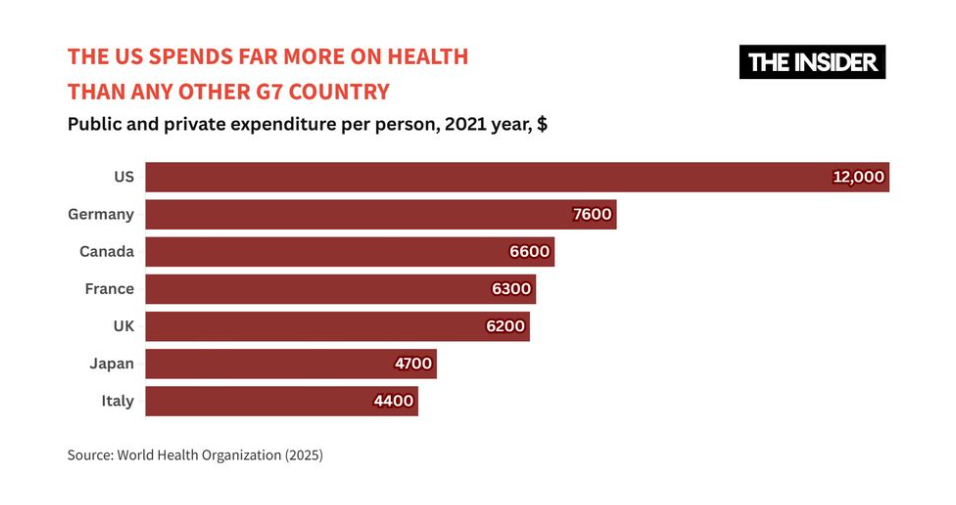Welcome to DU!
The truly grassroots left-of-center political community where regular people, not algorithms, drive the discussions and set the standards.
Join the community:
Create a free account
Support DU (and get rid of ads!):
Become a Star Member
Latest Breaking News
Editorials & Other Articles
General Discussion
The DU Lounge
All Forums
Issue Forums
Culture Forums
Alliance Forums
Region Forums
Support Forums
Help & Search
General Discussion
Related: Editorials & Other Articles, Issue Forums, Alliance Forums, Region ForumsWealthy but not healthy: Why U.S. healthcare is so expensive and ineffective, and what Trump will (not) do to change it

https://theins.press/en/economics/279868

The United States spends more on healthcare than any other G7 country, according to a March study by the Our World in Data project. Yet among G7 nations, the U.S. ranks last in life expectancy and lags behind on most other health indicators. Healthcare has long been a central issue in American politics, and the debate only intensified after Luigi Maggione, outraged by the system’s injustices, killed a top executive of the country’s largest health insurance company. Amid the uproar, Donald Trump vowed to fix America’s “inefficient” healthcare system. So far, however, his only proposal has been to make medical service prices more transparent, a measure that experts argue will do little to improve healthcare accessibility. The root of the problem is far deeper: the U.S. is the only developed country without universal government health insurance. Not only does Trump oppose introducing such a system, but he even tried to repeal its weaker alternative — Obamacare — which had greatly increased the number of insured Americans. Meanwhile, about a third of Americans are forced to forgo necessary medications due to costs.

“Making America Healthy Again by Empowering Patients with Clear, Accurate, And Actionable Healthcare Pricing Information” — this is the title of an executive order signed by Donald Trump in late February. The order directs federal agencies to develop, within 90 days, a mechanism for disclosing actual, rather than estimated, prices for hospital and insurance services. In essence, the new directive is meant to reinforce the “Improving Price and Quality Transparency in American Healthcare” order, which Trump signed in 2019 during his previous term. That order required hospitals to publish detailed, user-friendly price lists and mandated that insurers disclose negotiated rates with providers while also delivering discounted prices for prescription drugs.

“You're not allowed to even talk about it when you're going to a hospital or see a doctor. And this allows you to go out and talk about it,” Trump told reporters at the signing. “It's been unpopular in some circles because people make less money, but it's great for the patient.” In reality, however, the systemic problems of American healthcare are far too deep for this executive order — or any other — to root out. The issue lies not in specific regulations, but in the very foundation of the system itself.
The sickest among the wealthy
The United States is the richest country in the world, but far from the healthiest. Over the past 40 years, the U.S. has fallen far behind other developed nations in life expectancy. In 1980, the gap was less than a year (73.7 vs. 74.6), but by the early 2020s, it had widened to more than four years (78.4 vs. 82.5). Despite having the highest healthcare spending among developed countries, the U.S. has the lowest life expectancy for both men and women.

snip
1 replies
 = new reply since forum marked as read
Highlight:
NoneDon't highlight anything
5 newestHighlight 5 most recent replies
= new reply since forum marked as read
Highlight:
NoneDon't highlight anything
5 newestHighlight 5 most recent replies
Wealthy but not healthy: Why U.S. healthcare is so expensive and ineffective, and what Trump will (not) do to change it (Original Post)
Celerity
Friday
OP
ck4829
(36,870 posts)1. Unacceptable